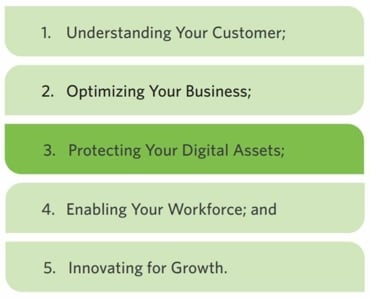The last 16 months of dramatic change driven by the global COVID-19 pandemic has placed a spotlight on key business outcomes and accelerated Digital Transformation in Architecture and Engineering (A&E) firms. Each of these outcomes, coupled with how people and processes can be empowered digitally through the application of technologies, will be explored in this five-part series for firms. The series aims to provide insights into the five critical business outcomes:

Part 3: Protecting Your Digital Assets
A&E firms have plenty to protect. From company-run platforms, data-sensitive accounts, and cryptocurrency transactions, much of a firm’s daily operations are digital. A&E firm’s digital assets such as customer lists and data, intellectual property, proprietary processes, and work products are becoming increasingly popular targets for cyber-attacks.
Cyber dangers such as phishing, ransomware, password-hacking and data breaches can paralyze a firm. Coupled with the COVID-19 pandemic driving a more remote workforce, conditions present a breeding ground for cyberattacks exposing A&E firms to increased vulnerabilities. As firms continue to advance their digital
initiatives, understanding potential threats and how to mitigate risks will play a pivotal role in their defense.
Coupled with a mature data management process, establishing a cyber security architecture where a firm’s people, data, processes and tools are aligned is foundational and a key first step in a firm’s defense against cyber threats.
A cybersecurity architecture combines security software and solutions to ensure all components of a firm’s IT infrastructure are protected to include cloud, networks, IoT, endpoints and mobile. Building a security framework that is all encompassing specifies the organizational structure, standards, policies, and functional behavior of a firm’s computers networking and other assets, should focus on various components of how cyber and computer systems are organized, synced, and integrated.
Beginning with the framework, firms must evaluate business assets, risks, and the overall impact of these vulnerabilities. Mapping out the design and architecture of how security services are structured and evaluating the framework to ensure all digital assets are protected is critical to risk exposure. Next, a thorough security policy must be defined to outline how each entity accesses each other, operations to be carried out by entity, level of protections for systems and actions defined if security requirements are not met.
Implementation of the security architecture will include ensuring the defined security policy, standards, decisions, and risk management are effectively implemented both in the immediate and long-term and that sustainable monitoring practices are established.
Whether internal expertise or a trusted outside partner is hired, cybersecurity must be a strategic priority for A&E firms. Establishing and continuously reevaluating a firm’s cybersecurity architecture and its proper execution is the best defense to keeping a firm’s digital assets protected.
To learn more about how Cherry Bekaert can assist in your Digital Transformation visit us here.
Related Insights:
- Digitally Driving Business Outcomes (A 5 Part Series) – Part I: Understanding Your Customer
- Digitally Driving Business Outcomes (A 5 Part Series) – Part 2: Optimizing Your Business
- Digitally Driving Business Outcomes (A 5 Part Series) – Part 4: Enabling Your Workforce
- Digitally Driving Business Outcomes (A 5 Part Series) – Part 5: Innovating for Growth





